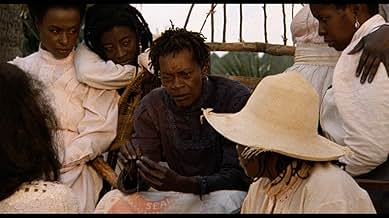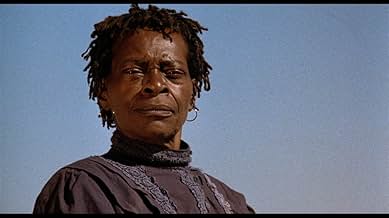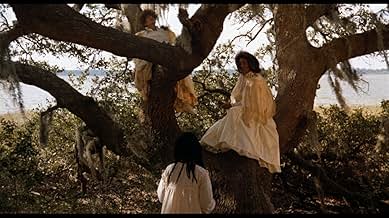CALIFICACIÓN DE IMDb
6.6/10
3.6 k
TU CALIFICACIÓN
Agrega una trama en tu idiomaA languid, impressionistic story of three generations of Gullah women living on the South Carolina Sea Islands in 1902.A languid, impressionistic story of three generations of Gullah women living on the South Carolina Sea Islands in 1902.A languid, impressionistic story of three generations of Gullah women living on the South Carolina Sea Islands in 1902.
- Dirección
- Guionista
- Elenco
- Premios
- 4 premios ganados y 2 nominaciones en total
Barbara O
- Yellow Mary
- (as Barbara-O)
Tony King
- Newlywed Man
- (as Malik Farrakhan)
- Dirección
- Guionista
- Todo el elenco y el equipo
- Producción, taquilla y más en IMDbPro
Opiniones destacadas
Julie Dash grew up in Long Island, New York and graduated from CCNY right after high school with a degree in film production. Dash moved to L.A. only to be rejected by UCLA's film department, but later accepted as a student of the American Film Institute through a fellowship. Grants then started rolling in and Dash was able to begin writing and shooting films which revolved around true historical portrayals and images of African woman such as depicted in Daughters of the Dust. This film was written, directed and then released by Julie Dash in 1991. The historical context of this film stretches from the time of the slave trade up to the summer of 1902, when the Peazant family left an island off the coast of South Carolina and headed north for the mainland. I would consider this film to be within the genre of modern melodrama because of the overly emotional acting styles, complex plot, long monologues and excellent musical score which seems to parallel the moods in each scene perfectly. I also found the mis en scene, as far as the setting, costume, figure movement and expression and cinematography to be very well done. This is an intense film definitely worth watching.
I really wanted to like this, but other than visually, there wasn't much to appreciate. A stronger storyline would have been nice.
It does however inspire me to visit the area and look into the history, but I wish the movie itself had told me more.
Kudos for the effort.
It does however inspire me to visit the area and look into the history, but I wish the movie itself had told me more.
Kudos for the effort.
A Feast For the Eyes, Ears, And Heart, March 26, 2001 Reviewer: Angela Jefferson (see more about me) from Memphis, Tn USA In the opening of her film, Daughters of the Dust, Julie Dash alerts the viewer that this is no ordinary African American story. Conversely, this is an American history lesson with African origins. A small informative note at the start of the film puts the entire movie in context. Without this explanatory foreword, many viewers would probably find the film hard to understand. Though the movie tells the story of the Peazant family's migration from the sea islands of the South, the story also gives a panoramic view of the Gullah culture at-large. Because the islands are isolated from the mainland states, the Gullah retain a distinct African ethnicity and culture. Ironically, the Peazants want to rid themselves of the old ways and heritage, thus beginning an exodus from the islands to the mainland. Taking place in 1902, just fifty years after the end of slavery, Daughter of the Dust explores the Peazant's struggle for survival and escape from poverty. The movie opens on the eve of the family's great migration to the mainland. A family celebration and farewell-of-sorts take place on the beach. The Peazants even hire a photographer to document this momentous occasion. As the movie progresses, the complexity of the family's departure from the island emerges. Difference and changing values mire the pending migration with conflict and strife. As the family prepares to leave, in search of a new life and better future, the film reveals the richness of the Gullah heritage. Narrations of "the unborn child" of Eli and Eula Peazant offer glimpses into problems the family has faced since their existence on the island. As explained by matriarch Nana Peazant, the Gullah are like "two people in one body." Though most Peazants were born in the Americas, their African heritage is forever evident. The internal conflicts of this duality haunt the family as they become ensnarled in battle, only to war against themselves. Through old African customs and rituals, such as glass bottle trees, salt water baths, and herb potions, Nana wants to ensure that the family stays together. Moreover, Nana, "the last of the old," has chosen to stay on the island. She celebrates everything that makes her who she is: the ugly and the good. She knows slavery and she knows freedom. Her life revolves around the continuation and strengthening of the Peazant family. Her rituals are often unappreciated and looked upon with scorn by other family members. Some family members are unwilling to grasp Nana's teachings and wisdom. They want to escape the island, to run away from the Gullah way of life. However, they cannot run from themselves. Just as Nana proclaims, they will always live a double life, no matter where they go. The trip to the mainland certainly cannot rid their indigo stained hands of its blue-blackish tint. Nor can the northern journey erase the memories of whom or what they are leaving. Unbeknownst to the younger Peazants, the duality, the recollections and remembrances, and the old way and traditions are gifts from their ancestors. Sadly, few are able to accept these gifts or comprehend their importance. Through authentic Gullah dialect, vivid imagery and colorful characters, Dash reveals the uniqueness of the Gullah people. A cousin, Yellow Mary, returns from Cuba to the island, facing the scorn of her people because she is a "ruint 'oman." Haggar, a bitter woman who wants nothing to do with the old Gullah ways, does not realize that she cannot rid herself of whom she is. For example, she despises the "old Africans," yet retains their ways in her speech and use of African colloquialisms. Another cousin, Viola is full of Christian religious fervor and against the heathen practices and nature-worshiping traditions of her people. Eula, who gives a heart- wrenching soliloquy at the end of the movie, bears the burden of pregnancy and rape by a white man. Eli, Eula's husband, represents the strength and future of the Peazant clan. Besides being adept at character development, Julie Dash effectively educates the viewer about African-American history. Tales of flying Africans, water-walking Ibo, Islamic religion, and slave trading are skillfully woven in small snatches throughout the film. We also see connections between African-Americans and Native Americans. The lessons learned from this film are too numerous. One must see the film more than once to appreciate all the information presented. Daughters of the Dust awakens all the senses. The beautiful cinematography transports viewers to a surreal place and time, creating a visual paradise. Each scene makes its introduction with mesmerizing African music, which aptly fits each setting. As the Gullah women prepare food for the feast, one cannot help but imagine the taste and smell of gumbo, shrimp, and crab. This movie also arouses the heart. One can easily identify and empathize with the characters' passion and sincerity. Often, the characters relay sentiments and convictions so convincingly, that it is hard to believe that the players were acting. Understanding complete passages is often difficult because of the beautiful and authentic tonality of the language. Nonetheless, the use of standard English could not have conveyed Dash's message as successfully. We should appreciate this film for its originality and courage. Stories such as these are hardly ever told. Most films neglect the eclectic nature of the African American community, usually focusing on only aspects that are familiar to the masses. Here, Julie Dash reaches beyond the boundaries that are set for African-American films. Equally as important is her ability and willingness to validate the African-American experience. She eloquently and subtly deals with difficult subjects such as slavery, self-hatred, feminism, color prejudices, and rape. Dash does not throw one viewpoint in your face. Conversely, Dash gives the viewer a front row seat into the lives of a remarkable people. We are then left to draw conclusions for ourselves. One feels liberated, proud, and honored to be allowed a window into their lives. The movie is a celebration of the African-American diaspora. The images, language, and music of Daughters of the Dust will linger in the minds of its fortunate viewers forever.
Daughters of the Dust is film that slits the eyes of spectators who have been fed only linear and simplistic narrative/plot dev'ts through hollywoodism and can't possibly fathom any other way of being/thinking. It is truly an excruciating film to watch for those who have not dreamt and lived the "double consciousness" of modernity, for those who do NOT want to recall and remember the fact of american quilombos, maroon societies, slave revolters and runaways who succesfully established another way of life, not based on european dominance. This story is about the struggles of maintaining that community in 1902, a turning point in the life of this one maroon society. Dash breaks with cinematic codes in her experimental reconstruction of historical memory...a forgotten episode in African american history, a forgotten place, re-calling back to life ancestors that had survived and thrived: The Gullahs, Peazant family, persisting, unerasable, as the unborn child running through our memory, coming out of our past, forging a new and alternative future: a future that rejects the limitations of western epistemology. The summoning of these images to screen from the unwritten (african) past provides its own logic and development which Dash successfully visualizes in a polyphonic tradition, many voices, multiple perspectives. She does not allow a simplistic and individualistic rendering of this history...NO!she allows the struggle of divergent african perspectives, Christian, Muslim, Africanist, Native American to emerge in the same frame, to address that age old question: To exist or not to exist, to bear witness or to forget. In order for this history to exist and bear witness, Julie Dash does not allow any conventional reductionary scheme of narrativity, her temporal references are not linear. Her story is told through palimpestic time, the past present and future, overlapping and disjunctive: rupturing our understanding of history/memory and identity. The conflict that drives the film's narrative is not individual ego/conventional good vs bad drama/or boy gets girl(Hollywoodism); the conflict is how will the communal memory of these African survivors be salvaged from the ravaging of modernism's erasure..We see the family eat their last supper as the rite of passage to a life on the other side, a side that the ancestors fought to diverge from...The film is testimony to the african ancestors and to the spirit of resistance of slave revolters. Many people have offered criticism of dash's "feminism." Feminism is a problematic concept to apply to this film, no it is not feminist, it is afro-centric, matri-focal, and woman, as bearer of culture and memory as mother to the community, becomes the embodiment of that struggle. (of course it is not "feminist": it doesn't speak about abortion law, equal pay, etc etc..this kind of feminism is eurocentric and simplistic..) Thank you Julie Dash, i am not african american but the tears poured down my face as i, too, recalled that life left behind, another time another place. A place where people, muslims/christians/indigenous or any other can actually co-exist peacefully side by side, respectful of each other's differences. The character who chose to leave her so called "civilized" mother at the last minute, to take off with her Native American lover..is one of the most powerful onscreen testimony of love between indigenous peoples that has ever been made.
"Daughters of the Dust" isn't an easy work, but it's a very fine accomplishment, and one of the most important African American films of the last 20 years.
Julie Dash has chosen to share with her audience a chapter of black history that is still new to most white Americans, the internal issues that came with Black Americans as they made their way North in the years between 1900 and 1920. The separation from the soil, the divorce from those remnants of West African culture that survived through the holocaust of slavery. The psychic tearing of the transition from rural to urban culture. The skin game that Yellow Mary and other "fair skinned" Black people had to play in order to survive in White America. If the film is boring to many, let it be plainly said that it is boring for many because the film maker courageously chose to examine a piece of history that most White Americans- and many Black ones- no longer care much about.
If you want to be entertained, this isn't a film you'll enjoy. "Daughters of the Dust" offers instead an opportunity to probe deep, to look close at the dreamy quality of an internal life, and a balanced relationship with the earth, that most of our peoples in the United States have chosen to leave behind them for exactly the wrong reasons. Let those who have difficulty thinking about these things stick to action films. "Daughters of the Dust" is about something more akin to the sense of wonder that's being rapidly stamped out of many of us in the name of mom, apple pie, and the gross national product. It is worth not one, but many viewings. Julie Dash has created a masterpiece of American cinema.
Julie Dash has chosen to share with her audience a chapter of black history that is still new to most white Americans, the internal issues that came with Black Americans as they made their way North in the years between 1900 and 1920. The separation from the soil, the divorce from those remnants of West African culture that survived through the holocaust of slavery. The psychic tearing of the transition from rural to urban culture. The skin game that Yellow Mary and other "fair skinned" Black people had to play in order to survive in White America. If the film is boring to many, let it be plainly said that it is boring for many because the film maker courageously chose to examine a piece of history that most White Americans- and many Black ones- no longer care much about.
If you want to be entertained, this isn't a film you'll enjoy. "Daughters of the Dust" offers instead an opportunity to probe deep, to look close at the dreamy quality of an internal life, and a balanced relationship with the earth, that most of our peoples in the United States have chosen to leave behind them for exactly the wrong reasons. Let those who have difficulty thinking about these things stick to action films. "Daughters of the Dust" is about something more akin to the sense of wonder that's being rapidly stamped out of many of us in the name of mom, apple pie, and the gross national product. It is worth not one, but many viewings. Julie Dash has created a masterpiece of American cinema.
¿Sabías que…?
- TriviaSelected to the Library of Congress National Registry of Film in 2004.
- Citas
[first lines]
Nana Peazant: I am the first and the last. I am the honored one and the scorned one. I am the whore and the holy one. I am the wife and the virgin. I am the barren one and many are my daughters. I am the silence that you can not understand. I am the utterance of my name.
Selecciones populares
Inicia sesión para calificar y agrega a la lista de videos para obtener recomendaciones personalizadas
- How long is Daughters of the Dust?Con tecnología de Alexa
Detalles
- Fecha de lanzamiento
- Países de origen
- Idiomas
- También se conoce como
- Дочери пыли
- Locaciones de filmación
- Productoras
- Ver más créditos de la compañía en IMDbPro
Taquilla
- Total en EE. UU. y Canadá
- USD 1,683,422
- Fin de semana de estreno en EE. UU. y Canadá
- USD 10,842
- 20 nov 2016
- Total a nivel mundial
- USD 1,689,776
- Tiempo de ejecución1 hora 53 minutos
- Color
- Relación de aspecto
- 1.85 : 1
Contribuir a esta página
Sugiere una edición o agrega el contenido que falta

Principales brechas de datos
By what name was Daughters of the Dust (1991) officially released in India in English?
Responda




























